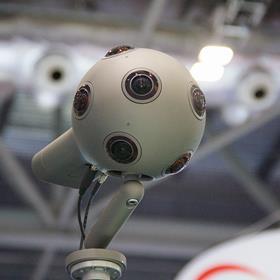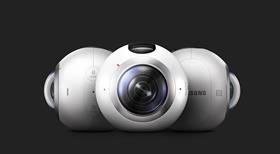Producing virtual reality content for any of the many VR headsets now available is no longer a concept confined to gaming or the IBC Future Zone.
And with so many people able to access content via their smart phones, broadcasters are increasingly interested in VR and 360-degree video.
There are already a handful of low-cost consumer 360-degree cameras available, and several professional systems, although there isn’t one VR rig that does everything.
Director of Photography Rob Hollingworth, who specialises in natural history, sometimes shoots with several different VR rigs to take advantage of their various strengths.
He then selects the best of each rig during the post-production process.
Many of the professional rigs use multiple GoPro cameras, but this approach can be problematic.
“The more cameras you throw into the mix, the quicker everything goes wrong and GoPros are reliably unreliable,” says Hollingworth.
”You’re making them do something they don’t want to do. If you take them somewhere hot, they will overheat, one camera will die, there will be an SD corruption; something goes wrong regularly with the GoPro rigs. That said, they are high resolution, a fantastic camera, great underwater and low cost.”
BBC R&D has been experimenting with VR and most of what it has shot has been on GoPro-based ball rigs, but it has used less-expensive consumer systems, such as the twin-lens Ricoh Theta “which worked particularly well in bright sunlight” according to Alia Sheikh, Senior Development Producer, BBC R&D.
However, the choice isn’t just as simple as cost, and there are two different architectures to consider.
Modular versus unibody
Most consumer cameras, and some high-end systems, come with everything built in, which can make them less flexible than many modular set-ups, such GoPro-based systems.

The Nokia Ozo, which costs about $45,000, is probably the most widely used professional VR camera.
“It is the closest to an industry standard,” says Alx Klive, Chief Executive, 360 Designs, which specialises in live VR.
“The Ozo is a fantastic camera,” says Hollingworth. It is relatively easy to set up, put a wireless link on it and see what it is doing. “It manages bright light particularly well.”
However, it is not without some drawbacks, says Klive. “The main issues with it are that it overheats; Radiant Images, who rent them in Los Angeles, have modded theirs with fans.”
It is a stereo camera and because of the battery pack at the rear of the unit it covers about 200-degrees, .
There is also the Jaunt One, which uses 24 custom HD sensors and is only available for hire. Its internal architecture is USB, which means it can’t be used for live productions.
360 Designs builds its own cameras; its first one had 42 cameras in a 60cm ball, which was “completely impractical for most use,” admits Klive.
He believes the concept of a ball of cameras will become more relevant in future because it can use parallax effects to take advantage of more advanced stitching methods.
Klive claims the latest 360 Designs Mini Eye is possibly the second closest to an industry standard.
“The image quality is better than the Ozo. It’s a third of the price,” he says. The modular design is based on Blackmagic Design Micro cameras.
It can be used with a six-camera, four-camera or three-camera rig. “Different shooting circumstances call for different geometries of cameras,” says Klive.
The Mini Eye costs £10,000 to £12,000 depending on options.
Drone work
“A three-camera rig is great for live use, but a four-camera rig better because you’ve more overlap for when you are going to be doing more advanced stitching in post,” explains Klive.
“We do a lot of drone work at the moment, and we have clients who want to stitch out the drone - you can take a four camera rig and mount one on top and that way you can stitch out the drone with a shot of the sky.”
The modular approach also allows the use of existing standards and workflows.
“With a unibody camera, you can’t get at the signal,” he says, making it difficult to go live. “Our cameras have 4K SDI coming out. You also get some regular 2D 4K cameras out of it.”
His broadcast customers like that they can use those four cameras on a reality TV show. “So even if this 360-degree VR thing doesn’t work out they’ve got another use for the cameras, which protects their investment.”
Nowhere to hide
One problem with shooting VR is that everything is visible - including the production team or, if they are hiding behind a tree, the tripod.
To counter this, Matthews Studio Equipment designed the VRig which it described as “the first professional grade camera support system that is specifically designed for VR capture.”
It has a small footprint to minimise nadir hole and shadow obstruction, but should be stable thanks to a low-centre-of-gravity barbell weight retainer that works with standard or Olympic style weights.
There is also an optional suction pump cup for non-porous surfaces and an Auger Spike for exterior use.
The VRig has a slim vertical riser and a black elastic leg skirt, to conceal camera accessories and make it even easier to paint out in post, while integrated tapped female mounts for light fixtures and microphones help address the rigging challenges while remaining inconspicuous. It also integrates with standard grip equipment.
Buying choices

Probably the tiniest professional 360-degree camera so far is Indiecam’s NakedEye, costing about $9,000, which has two square 2Kx2K global shutter sensors giving a resolution of 4K at 50/60p, with full control over all camera settings.
Weighing 380g it records CinemaDNG Raw files and Indiecam provides a streamlined post-production workflow for NakedEye, including sophisticated stitching algorithms.
Also offering CinemaDNG capture is the Sphericam Beast, which uses four 1-inch 4K sensors and four M.2 SSD drives to capture uncompressed 360-degree video at an output resolution of 5780x2890 at 50/60p (unstitched) and 10-bit raw, or live stitched output at 4K 30p.
For budget use, Hollingworth recommends the Nikon 360 (under £400, or $495), which he says work well in bright light. They are also waterproof to 30m without a separate housing.
The 4096x2160p (24fps) camera also self-stitches images, so you can “just fire and forget,” he adds.

Atlantic Productions VR Director James Manisty who also specialises in natural history, recommends the Samsung Gear 360 as a relatively cheap (under £300, or $370) consumer camera, which has two 2Kx2K cameras built in offering 3840x1920 output. However, it can only be controlled by high-end Samsung phones.



























No comments yet